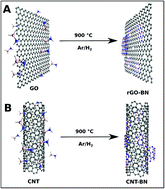Interface and defect engineering of hybrid nanostructures toward an efficient HER catalyst†
Abstract
The hydrogen evolution reaction (HER) plays a key role in hydrogen production for clean energy harvesting. Designing novel efficient and robust electrocatalysts with sufficient active sites and excellent conductivity is one of the key parameters for hydrogen production using water splitting devices. Recently, low-dimensional carbon materials have gained attention as metal-free catalysts for hydrogen production. Such nanostructures need to be engineered to improve their catalytic activity. Here, we designed and synthesized a B and N doped carbon nanostructure (CNS)–hBN heterostructure as an improved HER catalyst. The hBN layers on CNS could provide exposed defects and edges that act as active sites for proton adsorption and reduction. The composition, structure and chemical properties of the B and N doped CNS–hBN heterostructure were tuned to obtain excellent HER activity. Detailed morphological, structural and electrochemical characterization demonstrated that the synergistic effect rising from the interaction between B and N doped CNS and hBN structures contributes to enhance the electrocatalytic performances. To get more insight into the role of defects and doping, we performed density functional theory (DFT) calculations on the CNS–hBN heterostructure.



 Please wait while we load your content...
Please wait while we load your content...